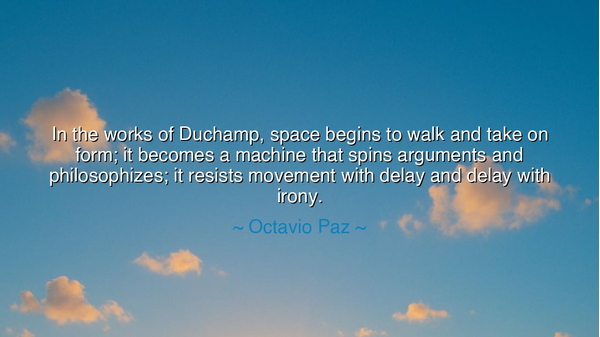
In the works of Duchamp, space begins to walk and take on form;
In the works of Duchamp, space begins to walk and take on form; it becomes a machine that spins arguments and philosophizes; it resists movement with delay and delay with irony.






Hear now the words of Octavio Paz, poet and seer of the modern age: “In the works of Duchamp, space begins to walk and take on form; it becomes a machine that spins arguments and philosophizes; it resists movement with delay and delay with irony.” This utterance is no idle praise, but a meditation on the radical genius of Marcel Duchamp, whose art broke the chains of convention and dared to question the very foundations of perception. Paz, with the eyes of a prophet, beheld not mere objects on canvas or sculpted forms, but a new reality in which space itself was alive, mocking the boundaries that sought to contain it.
In Duchamp’s work, space is no longer a silent background, no longer a stage upon which art and life perform. It becomes an actor in its own right, a restless traveler. It walks, it philosophizes, it contorts itself into paradox. Where once art was content to portray the stillness of objects—a vase, a face, a landscape—Duchamp seized the unseen intervals, the pauses, the strange mechanics of perception itself. He showed that the unseen can be more powerful than the seen, that the silence between notes may contain more meaning than the notes themselves. Thus, form is reborn, not as a thing, but as an idea in motion.
The machine of which Paz speaks is not made of gears and pistons, but of thought itself. Duchamp’s great creation, the “Large Glass,” is less a picture than a riddle: fragments of desire, irony, delay, and invention woven into one strange instrument. It spins arguments as a wheel spins thread, not to clothe the body but to clothe the mind. Each angle, each pause, each transparent plane is a challenge to the viewer: What is art? What is motion? What is time? The machine does not move forward like a carriage; it moves inward, into thought, into paradox, into the eternal dance between presence and absence.
Consider how this spirit echoes through history. The philosophers of Greece once gave the world paradoxes of movement, such as Zeno’s arrow, which forever moves yet never arrives. Duchamp, like a modern Zeno, paints not the arrow itself, but the strange delay between release and arrival. He clothes irony in glass and motion in stillness, teaching that what resists explanation is often the birthplace of new understanding. Just as Heraclitus spoke of the river that changes with each step, Duchamp shows us that even the simplest gesture is laden with contradiction, and that irony itself may be the purest form of truth.
The story of Duchamp reminds us of Galileo, who dared to turn his telescope to the heavens and see that the universe was not as men had thought. His discovery was resisted, delayed, mocked with irony by his age, yet it endured, reshaping the world. So too Duchamp: his art was laughed at, dismissed as trickery, yet it survived to transform the very language of modern creation. Both men reveal the same truth: that those who challenge perception are first ridiculed, then resisted, but finally revered as visionaries.
The lesson is clear. Do not fear the delay, nor the irony, for they are signs that you are on the path of transformation. What resists you may be the very force that sharpens you. Like Duchamp, dare to question the forms given to you; ask not only what is, but what could be. Let your space walk, let your ideas move freely, even if they stumble. Remember that every hesitation, every pause, every moment of mockery may conceal a hidden doorway into deeper wisdom.
Practical action flows from this vision. When you create, when you think, when you live, do not cling to the expected pattern. Allow space in your life—room for paradox, for stillness, for irony. Do not rush to fill every delay; sometimes the pause is the teacher, and the silence is the master. Seek to build not only objects, but machines of thought, structures that provoke questions rather than settle them. For in the act of questioning, in the restless walking of space itself, we touch the edge of the infinite.
Thus, Paz’s words become a beacon: art is no longer confined to canvas and stone; it is the very air, the pause, the irony of existence. In Duchamp’s vision, the world itself becomes a philosophical machine, forever resisting, forever delaying, forever teaching. Let us embrace this irony, and find in it not despair, but freedom—the freedom to reinvent perception, to walk in the infinite space of the human mind.






AAdministratorAdministrator
Welcome, honored guests. Please leave a comment, we will respond soon